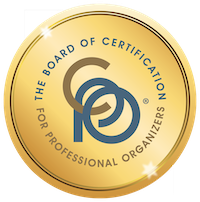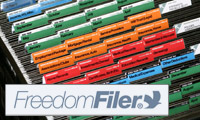Starting the new year with a clear desk
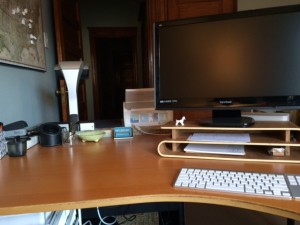
If you’re like me, the week between Christmas and New Year’s is one of planning and creating order. Last Friday I did a personal planning retreat and set some goals for 2017. That felt great. This week, I’m cleaning up some clutter spots in my office and trying to finish up some projects.
I wrote a post for my genealogy blog, Organize Your Family History with step-by-step instructions for clearing off a genealogy research desk. I’ve adapted it here, because it really applies to desks of any sort!
If you can’t remember the last time you saw the surface of your desk, perhaps it’s time to experience the joy of a clean desk. I know that time is limited and cleaning up your desk may not rank high on the list of ways you’d like to spend your time. but it’s worth it. When you sit down at a clear desk, your mind is more clear and you can be more focused on your research.
Here’s some good news: It doesn’t have to be hard or time consuming. Just follow this step-by-step method for creating some order on your desk, swiftly.
- Set your timer for 25 minutes.*
- Clear everything off your desk (and I mean everything except, perhaps, your computer). Put like things together into rough categories as you go. (For example, put papers together in a pile on the floor near your desk; put office supplies together, etc.) It might be helpful to have some bankers’ boxes or plastic totes handy to hold the categories, but the floor will do too.
- Put away the items that already have homes. For example, put binders and books where they belong. If something belongs in another room, put it in a box or bin that you’ve marked “Relocate to Another Room” so you don’t wander away from the room you’re working on. At the end of the session, you can put all that stuff away.
- Go through the non-paper items and put back on the desk only those things that deserve to take up such prime real estate. Only items used daily should merit being placed within arms’ reach when you’re sitting at your desk (with the possible exception of items that give you great pleasure to look at). Relocate or discard the other non-paper items that were on the desk.
- Take all those papers and put them in a box of some sort. Mark that box “Backlog.” (I use a box similar to this one from IKEA for that purpose and I place that box on a shelf.)
- Every time you’re at your desk, set a timer for ten minutes and go through the papers in the backlog, discarding, scanning and/or filing as required. Do this ten minutes a day for as long as it takes to eliminate the backlog. (You might be surprised how few of these short sessions it takes.)
- Don’t add to the backlog box. Instead, at the end of each day take the time (probably less than five minutes) to clear off your desk and put everything away. That way, you’ll start each session fresh.
*When your timer goes off, stop what you’re doing and take a five-minute break. Then set it for another 25 minutes and get back to work, unless you’re done.
Use your empty boxes to ship stuff (free!) to Goodwill
I just learned on Facebook about Give Back Box, a program that makes it really easy for you to donate to Goodwill, while reusing empty boxes. I think it’s just plain brilliant. After you’ve received something in the mail, fill the empty shipping box with items you’d like to give to Goodwill, rather than taking it to the dumpster. Then go to Give Back Box website and print a free shipping label. It will be pre-addressed to the nearest participating Goodwill. Then all you have to do is tape the label to the box and take it to UPS or the Post Office. You can even request a pick up. It’s all free to you.
Here’s a video that explains it:
I love the idea of keeping a box handy to put donated items in the minute you decide to let something go. Once it’s full, tape it up and send it away!
Staying on top of your email inbox

I’m struck by how similar our email inboxes are to physical clutter. Many people deal with physical clutter, but I bet even those who manage to keep a tidy home have email inbox clutter.
Here are some of the similarities I see between a bulging email inbox and a cluttered home:
- Both clutter up your mind.
- Both make it harder to be efficient.
- The idea of tackling either can be overwhelming.
- Order can be maintained in both with daily action.
- Decluttering both can be achieved in small bits of time.
- Clutter in both is frequently the result of delayed decisions.
- Having an under-control inbox and a tidy home both feel great!
I try hard to empty my email inbox on a regular basis. (I wish I could say I do it daily but, these days, it’s more like weekly.) I went through my big email existential crisis in October and since then staying on top of email has become a lot easier.
Here are a few things I do to make sure the email doesn’t get out of control:
- I delete as much as possible and archive the rest. Now that I have an IMAP email server, archiving just takes a single click and the email is out of my inbox.
- I try to respond right away to any email that requires a response, ideally on the day it was received. Then I delete or archive the email.
- I forward emails that require later action to Evernote, then attach a reminder to them so the email is put in front of me, in the form of an email and an Evernote reminder, on a specified date and time. (If you use gmail, I think the Boomerang app does the same thing.)
- When the email inbox starts filling up (for me, that means more than 50 emails), I use a timer to get me on track. I typically set a goal number of emails (say, ten) and try to get my inbox down to that number by the time the timer goes off. Usually, I don’t set the timer for more then five or ten minutes at a time.
- I unsubscribe like crazy to newsletters and promotional emails. Unsubscribing is almost as easy as just deleting them. (For gmail users, the app unroll.me makes even easier.)
Like keeping a tidy home, the secret to keeping your email inbox lean is to not hang on to too much, to have a place to put emails away, and to spend a few minutes daily throwing and putting stuff away. When you do that, you can find what you need, when you need it, and not lose important emails or documents.
Isn’t that worth a little effort? It doesn’t have to be hard.
Floating: My secret weapon for goal setting
I love taking some time at the end of the year to create order and set some goals for the coming year. (I wrote about taking a personal retreat in my newsletter about it today.) I’m setting aside next Friday as a retreat day and the centerpiece of the day will be my appointment to float for 90 minutes at F.L.OA.T., my favorite flotation tank in St. Louis.
I first wrote about floating in January 2013, after my first float ever (in Portland, Oregon), in a post headed, Floating with my thoughts. Then, in February 2015 I wrote a post called The ultimate relaxing experience shortly after F.L.OA.T. opened in St. Louis. I ended up purchasing a monthly subscription, so I’ve been floating every month since. I have found it to be really beneficial to be alone with my thoughts for this time. I do my best business planning and get loads of insights while I float. (I bring along a float journal where I write down my insights immediately after the float.)
F.L.OA.T. has proven to be very popular and in fact, they’ve opened a second location in the St. Louis suburb of Maryland Heights, Mo. (The original location, which I go to, is just a mile from my St. Louis city home.)
St. Louis’s alternative weekly newspaper, The Riverfront Times, ran a cover story this week about the experience that I thought was particularly good: Float On: How Salty Water and Silence Are Changing Some St. Louisans’ Lives. I wanted to share the link here in hopes that you might explore the idea of floating if you haven’t experienced it.
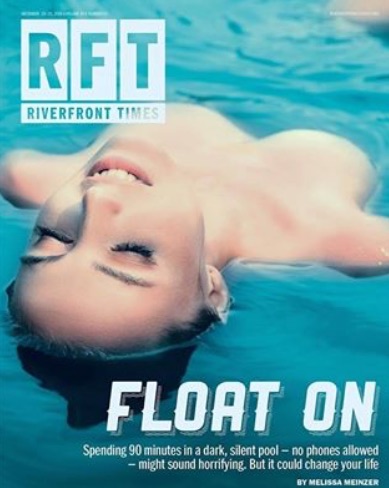
Regardless of whether you float or do something else for a personal retreat, I encourage you to take the time away from your busy life one day soon help you plan an amazing 2017!
Worth repeating: Packing light is worth the effort
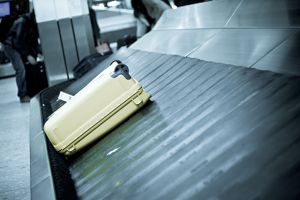
I’m in the midst of my annual December trip to visit family in Washington state. I wrote this post in January 2015, after circumstances required me to travel light on this trip two years ago. I realized in looking at the post this morning that I didn’t think twice about packing just a carry-on-sized bag for my nine-day trip. Since I’m in the midst of Project 333 and have only about 33 items of clothing from which to choose, it was a no brainer. Traveling is a great time to experiment with getting by with fewer clothes.
In early December I traveled to Washington state to visit my parents just days after I broke my wrist. I blogged then that I would have to simplify my travel taking the bare minimum number of items so that I could lift my suitcase with one hand. Since I also couldn’t fasten pants with a zipper, the number of clothing items I could take was limited anyway.
I really liked packing light. It had a number of advantages:
- My light suitcase made travel easier
- It was easy to carry my suitcase up the stairs at my host’s house
- Fewer choices for what to wear made dressing easier
- Unpacking took less time
Now I’m planning another trip to visit my parents, which is being tacked on to a trip to a genealogy conference. I’m a convert to packing light, but I also want to look good at my conference. That feels like a much bigger challenge.
I know I can do it, since my wardrobe is comprised of mix-and-match neutral separates (thanks to personal style coaching from my friend, Geralin Thomas). It’s going to take a little more effort as I plan what to pack. It’s much easier to just throw items into a suitcase just in case I might need them. But doing some planning and mindful packing before I leave will make my entire trip easier.
It seems ironic to me that packing light is can be more work than packing heavy. But I think it’s worth the effort.
Photo by Camilo Rueda Lopez via Flickr.
Amazon Prime: The ultimate clutter-free gift

I’ve been a member of Amazon Prime for years—well over a decade, I’m sure. I first joined when pretty much the only benefit was free two-day shipping (and it cost $79 annually). Now the price is up to $99 but to me it’s an amazing bargain. The free shipping is great. But they have added some benefits that make the $99 expenditure well worth it, even you never have a thing shipped.
I’m a big advocate of giving gifts that won’t create clutter and Amazon Prime fits the bill. (Except, of course, that it would make it easy for the recipient to acquire more physical stuff…but at least that stuff wouldn’t be a hard-to-part-with gift.)
In case you’re not aware, I’ll spell out the Amazon Prime benefits. It provides so many options for accessing information and entertainment, all for $99 a year.
- Free two-day shipping. You not only get your stuff shipped free, it comes more quickly! In certain metropolitan areas, Prime Now offers free same-day delivery is available for certain items.
- Amazon Prime Video. At no additional charge, you can stream certain TV shows (including a library of HBO shows) and movies, as well as Amazon Original programming that is available nowhere else. There are some terrific Amazon Originals, including Transparent, Mozart in the Jungle, The Man in the High Castle, Bosch, and Catastrophe.
- Amazon Prime Music. I recently discovered that I can stream music free of charge and free of ads through Amazon. You can tap into curated playlists or listen to whole albums. I just realized that rather than spending $20 on the Hamilton Original Cast Recording album via iTunes, I could just stream it through Amazon Prime Music. And get this: you can display the lyrics, if you want.
- Audible audiobooks and Audible Channels. Until recently, I didn’t even know that Audible channels existed. I haven’t tried them out yet, but they’re original audio programming that look really interesting. (I’m starting to feel overwhelmed by all the options of things to listen to!) With Amazon Prime, you can stream certain audiobooks and (I think) all Audible Channels at no extra charge.
- Kindle First books. I’ve written here about how much I love my Amazon Kindle. I read three or four books a month on my Kindle, most of which I check out from the library. Recently, Amazon added Kindle First, which provides Prime Members a monthly small selection of pre-release books, one of which can be downloaded free.
- Kindle Owners Lending Library. With the Kindle Owners Lending Library, Amazon Prime members can borrow one book per month from a limited selection of books. The one caveat is that the borrowed books cannot be read on the Kindle app on other devices; they must be read on the Kindle itself. And you must return the current borrowed book before borrowing another. I’ve taken advantage of this benefit many times.
- Prime Reading. It was only in researching this post that I learned about Prime Reading, which allows free reading of a limited (but not small) selection of books and magazines on your Kindle or Kindle app. What blew me away is that I can read, free of charge, the current issue of certain magazines, including Entertainment Weekly. I subscribed to EW for 25 years before I stopped my subscription because my aging eyes found the type too small to read. I’m taking great joy in knowing that I have access to the current issue (and I can make the type big enough to enjoy!). With a single click, I delivered it to my iPad Mini.
- Prime Photos provides free, unlimited storage space for photos. I haven’t tried it, but if you’re looking for cloud storage for your photos, it might be worth looking into.
- Twitch Prime, for gamers, provides free access to Twitch’s game-streaming service. I don’t even really know what that means, but if you’re a gamer, you might want to check it out.
This isn’t a comprehensive list. For more details, check out the Prime Benefits page at Amazon or this article from DealNews, Amazon Prime Benefits You May Not Know About.
In the past, you couldn’t give Amazon Prime as a gift. But in 2013 that changed. Click here to purchase Amazon Prime as a gift. Of course, one downside to purchasing a subscription as a gift is that the recipient has to re-up (or you choose to keep giving the gift). If your recipient is using the benefits of Amazon Prime, though, they may be more than happy to renew their subscription.
The keys to orderly gift wrap
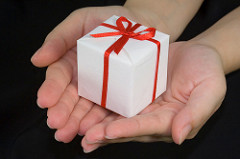
I see a whole lot of gift wrap in my clients’ homes. Christmas wrap, in particular, seems to take on a life of its own in my clients’ basements near their holiday decorations.
Storing gift wrap seems to be a perennial challenge for people. Here are some ideas for making it easier:
- Make your gift wrap accessible. I often see that clients will just buy more wrap if it’s too hard to get to the wrap they already own. I encourage you to move your wrap to a spot where you can easily access it.
- Use up what you have. Place a moratorium on buying new wrap. If you find yourself tempted to buy new wrap because you don’t like what you have, donate the old wrap before buying new.
- Let go of the wrap you don’t love. If you have wrapping paper that’s been sitting in your basement season after season because you never use it, why not donate it, so that someone who loves it can make use of it.
- Streamline your selection. I love the idea of having one “signature” gift wrap that you use for all occasions. Perhaps it’s white paper or brown Kraft paper. You could buy a roll and, if you have room, keep it on a dispenser for easy use. (Such large rolls and dispensers are surprising affordable at Paper Mart.) Think of all the time you’d save deciding which paper to use and figuring out if you have enough for a particular package.
- Don’t buy the extra-long rolls. Those 40” long rolls might make it easier to wrap large gifts, but very few commercially available gift-wrap storage solutions will accommodate them. (Here’s one.) I urge my clients to let go of those extra-long rolls when they’re decluttering and to stop buying them.
- Give fewer wrappable gifts. If you give clutter-free gifts, you have less to wrap and therefore less need for gift wrap.
I love a beautifully wrapped gift as much as the next guy. But I try hard not to accumulate a large collection of wrap. With gift wrap (as in other items, like cosmetics), the more you have, the harder it is to use.
Photo by asenat29 via Flickr. Used under Creative Commons License.
Links
- Ravelry
- Getting to Good Enough podcast
- Shannon Wilkinson, life coach
- Are you interested in becoming a professional organizer?
- Organize Your Family History
- Institute for Challenging Disorganization
- NAPO St. Louis
- Peace of Mind Spending
- National Association of Productivity and Organizing Professionals




